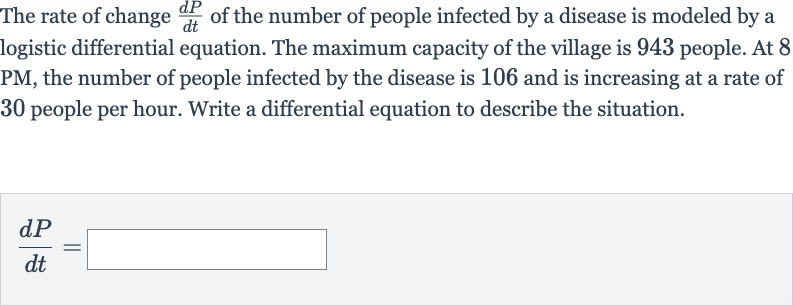AI tutor
Welcome to Bytelearn!
Let’s check out your problem:

The rate of change of the number of people infected by a disease is modeled by a logistic differential equation. The maximum capacity of the village is people. At PM, the number of people infected by the disease is and is increasing at a rate of people per hour. Write a differential equation to describe the situation.
Full solution
Q. The rate of change of the number of people infected by a disease is modeled by a logistic differential equation. The maximum capacity of the village is people. At PM, the number of people infected by the disease is and is increasing at a rate of people per hour. Write a differential equation to describe the situation.
- Logistic Differential Equation: The logistic differential equation is generally given by the formula:where:- is the current population (number of people infected),- is the growth rate (rate of increase of the infection),- is the carrying capacity (maximum capacity of the village),- is the rate of change of the population (number of people infected) over time.
- Given Carrying Capacity: We are given the carrying capacity people.
- Given Population and Rate of Change: We are also given that at a certain time ( PM), the number of people infected and the rate of change of the number of people infected people per hour.
- Finding Growth Rate: To find the growth rate , we can use the given rate of change when :Now we solve for :
- Calculating Growth Rate: Calculate the value of : (rounded to four decimal places)
- Writing Logistic Differential Equation: Now we can write the logistic differential equation using the value of and the carrying capacity :
More problems from Write exponential functions: word problems
QuestionGet tutor help
QuestionGet tutor help
QuestionGet tutor help
QuestionGet tutor help
QuestionGet tutor help
QuestionGet tutor help
QuestionGet tutor help
QuestionGet tutor help
QuestionGet tutor help
